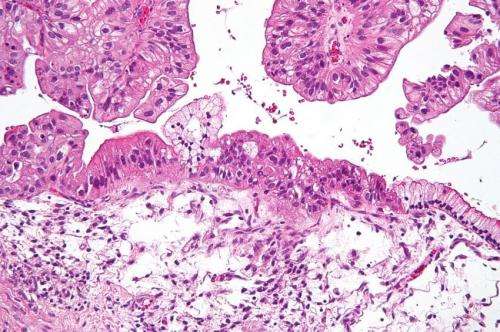Study identifies promising drug target in certain breast and ovarian cancers

The Food and Drug Administration's recent approval of the drug olaparib for ovarian cancer patients with inherited mutations in the genes BRCA1 or BRCA2 came as welcome news to the thousands of women now eligible to receive it. A new study by Dana-Farber Cancer Institute scientists indicates that the pool of patients who can benefit from the drug is potentially much wider – and offers a ready means of identifying them.
The study, published in the journal Nature, found that an enzyme called polymerase θ (or POLQ) is the active agent in the protein "pathway" that olaparib targets within tumor cells. The finding suggests that breast and ovarian cancer patients whose tumor cells carry abnormally high levels of POLQ are likely to respond to the drug – and that POLQ itself is an inviting target for future therapies.
"About 10-15 percent of ovarian cancers arise in women who have inherited mutations in BRCA1 or BRCA2," Alan D'Andrea, MD, Co-Director of Dana Farber's Gene Therapy Center and the senior author of the study. "Although olaparib is often effective in this group of patients, we haven't known precisely how it works.
By uncovering part of the biological machinery that olaparib operates on, we now have a rationale for making it and similar drugs available to a broader population of patients."
Olaparib belongs to a class of drugs known as PARP inhibitors, which target one of the mechanisms by which cells repair certain kinds of damage to DNA. It works by attacking a key vulnerability in tumor cells that carry mutations in BRCA1 or BRCA2.
BRCA1 and 2 specialize in repairing breaks in both strands of the DNA molecule – a critical activity, because such breakage can wreak havoc on cells' genetic programming. In people who inherit mutated versions of the BRCA genes, the process of double-stranded DNA repair is diminished but not defunct. Cells can activate a back-up repair pathway controlled by a protein known as PARP (poly-ADP Ribose Polymerase). It's an imperfect solution, however: while BRCA1 and 2 exemplify quality workmanship, the PARP team is more like a corps of hapless mechanics, introducing new DNA errors even as it fixes others.
In breast and ovarian cancer cells, a BRCA mutation represents strike one against their continued survival, because it increases their susceptibility to DNA damage. By targeting the back-up repair pathway controlled by PARP, olaparib and similar drugs deliver strike two. With both repair pathways dysfunctional, the resulting accumulation of DNA damage provides strike three.
While researchers knew that olaparib targets the PARP pathway, they didn't know precisely it and other PARP inhibitors work. To find out, first author Raphael Ceccaldi, PhD, of D'Andrea's lab, probed cancer cells for proteins whose levels shot up when BRCA1 or 2 was mutated. The protein that underwent the biggest increase was POLQ.
"We theorized that the rise in POLQ was compensating for the loss of BRCA, and that it is involved in DNA repair," D'Andrea remarks. "A follow-up experiment confirmed their hypothesis: When they shut down POLQ or PARP's activity in mice with BRCA-deficient breast cancer, the tumor cells died. Another set of experiments produced an especially dramatic result: Cross-breeding BRCA-deficient mice with POLQ-deficient mice resulted in embryos that died shortly after conception. With both DNA-repair pathways out of action, the embryos' cells couldn't survive."
These experiments identified POLQ as a linchpin of the PARP DNA-repair machinery. PARP itself is more of a damage-finder than a damage-fixer; its role is to direct POLQ and other elements of the repair corps to the damaged site.
"The discovery that cancer cells with BRCA mutations are utterly dependent on POLQ for their continued survival – and that normal cells are not – suggests that POLQ could be an ideal target for novel therapies," D'Andrea remarks. We're working on developing such therapies now."
















